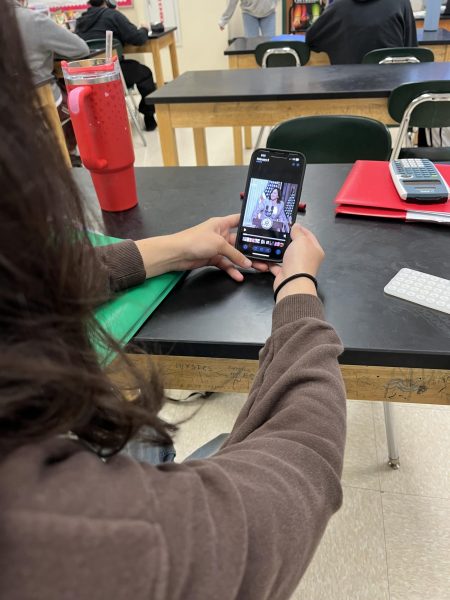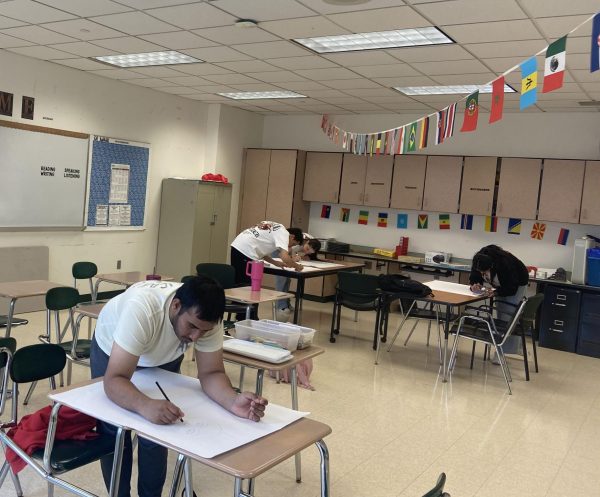Cellphones in the Classroom Part II: Teacher Point of View
As you read this article, how far away is your cell phone? If a message comes in before you finish reading, will you check it? The compulsion to stay connected at all times to one’s web of contacts is powerful. In the classroom, it often proves too great a force to resist.
Students and adults alike have become so conditioned to the signals of pocket-sized devices, that immediate response is automatic and interruption expected. Focused attention has become difficult to maintain. Because the temptation has proven too great for most to overcome, cell phones and other smart devices should be banned in classrooms at Dartmouth High.
Some will argue that those who are able to keep their devices tucked away during class time should be allowed to keep them there, and only those who are caught accessing them should have the devices confiscated. However, this practice puts too great a burden on the teacher, and poses too great a temptation for the student.
What about emergencies? Or occasional academic uses? These situations can be accommodated by placing phones in plain view near the door, easily accessible should the need arise.
The bottom line is that society needs to be saved from itself. Everyone, at times, has felt himself fall down the path of least resistance. When the speaker is boring, the content confusing, or weariness overwhelming, technology appears attractive and soothing. This is but a slippery balm, dulling the user’s tolerance for challenging circumstances.
Anecdotally, in classrooms where the use of devices is verbally discouraged, students begin the semester fairly attentively. However, when a permissive atmosphere is noted, many students slowly become less industrious and often withdraw from classroom activity into personal clouds of technology as the semester continues. The original state of industry shows that productivity is greater when students believe tech use is not an option.
Additionally, the practice of deliberately placing electronic devices out of reach during class will strengthen the habit, leading students to follow the pattern during home study as well. Therefore, academic productivity at home will also increase.
A further advantage of enforcing data silence is that students will have more opportunity to engage in class discussion, interact socially during breaks, and spend down time between assignments in quiet contemplation or imaginative fancy. Without access to easy distraction, students will be pushed beyond comfort zones of solitary entertainment toward increased interaction with others in their immediate environment.
In conclusion, the benefits of banning cell phones and smart devices in Dartmouth High classes far outweigh the temporary discomfort of the unplugged student. A cell phone positioned strategically is easily accessed when required, and does not endanger student safety. Essentially, with the absence of electronic interference, education will regain its preeminence in the classroom.













Ryan • May 25, 2017 at 12:32 pm
If I haven’t done something wrong, or abused the privilege of being able to bring my phone to school, then my phone shouldn’t be confiscated because someone else has a problem using their own during class. Students who follow the rules and use their phones during the allowed times should not be punished for other students mistakes…makes so sense. Also, taking cell phones from each student during every class is NOT going to change someone’s attitude towards that class, whether they will want to pay attention or slack off. If anything, it will make students more upset because you are taking away their property even if they’ve done nothing wrong.
Asher S • May 25, 2017 at 12:22 pm
I think students should be allowed to be on their phones if they finish an assignment. It’s unfair for an excelling student to be restricted when waiting for the rest of the class to catch up.
Sarah Labossiere • May 26, 2017 at 1:33 pm
I agree that students who complete assignments quickly (and comprehensively) should be allowed some “free time”. However, I believe utilizing phones during this time will not only make it more difficult for teachers to keep track of who is allowed phone use, but it may also prevent students from using their time in more “constructive” educational ways (by reading, working ahead, thinking or even resting!)
vik • May 25, 2017 at 12:21 pm
this gives me anxiety too
victoria • May 25, 2017 at 12:19 pm
lol
samantha dias • May 25, 2017 at 12:20 pm
lol
victoria • May 25, 2017 at 12:16 pm
i mostly disagree, we never signed up for our phones being taken away, because teachers get annoyed, lol i thought we were here to to get “educated” not being threatened of a phone being distracting
Mercedes DaCosta • May 25, 2017 at 12:20 pm
lol agreed
Mercedes DaCosta • May 25, 2017 at 12:15 pm
I disagree.
samantha dias • May 25, 2017 at 12:21 pm
me too
Bailey O • May 25, 2017 at 12:14 pm
Students should be allowed to have their phones on them and use them without a teacher confiscating them, but only if a student has a valuable reason to be on their phones.
kay • May 25, 2017 at 12:13 pm
“dulling the user’s tolerance for challenging circumstances.” this statement stood out to me and although it is true, phones within the school is not as challenging of an issue as it’s cracked up to be.
Tyler • May 25, 2017 at 12:13 pm
I believe that cell phones should only be confiscated from students who are regularly using them instead of focusing on schoolwork.
zach • May 25, 2017 at 12:12 pm
cellphones should be banned from the students who are causing the problems.
Jacob Almeida • May 25, 2017 at 12:11 pm
Cell phones should be allowed because cell phones are a good tool for education.
samantha dias • May 25, 2017 at 12:09 pm
i disagree, cell phones should not be banned if the students do not pay attention and fail there classes its on them not the teachers
anon • May 25, 2017 at 12:14 pm
good
Mercedes DaCosta • May 25, 2017 at 12:27 pm
good
Sean.K • May 25, 2017 at 12:08 pm
I think that students should have there phones on them but in there bags for emergencies.
Ashley Gagne • May 25, 2017 at 12:08 pm
I disagree.
Maegan Rose • May 25, 2017 at 12:13 pm
I disagree.
Anthony P. • May 24, 2017 at 2:00 pm
I disagree with the depiction of Dartmouth High students as tech junkies. Many students get by just fine without their phones, and in my opinion, its not as serious an issue as everyone plays it up to be.
hannah perry • May 24, 2017 at 1:55 pm
i feel as though this teachers reasoning’s are not accurate if she has no one to back her up. i think regardless if they get banned or not students still use them. more understanding if they ban them in the middle school but in high school everyone is grown up and basically does what they want.
Tom • May 24, 2017 at 1:47 pm
you’re missing a quote or two, or any
Hailey Tetreault • May 24, 2017 at 1:41 pm
I think if anything the time should be changed phones should be allowed up until the beginning at schools at like 7:30 a.m. and be blocked up until 2:03 p.m. with it allowed if a teachers okay with it and during lunch
ethan moniz • May 24, 2017 at 1:40 pm
i think phones should be allowed because not everyone is glued to them